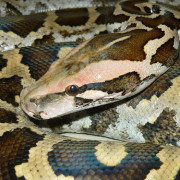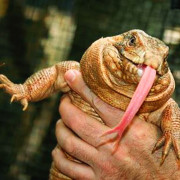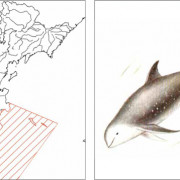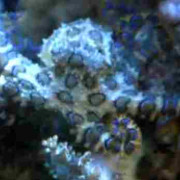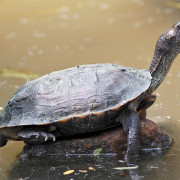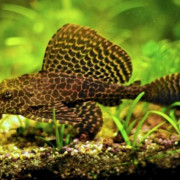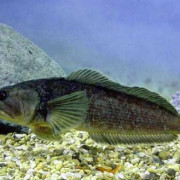Гигантозавр GigantosaurusГигантозавр Gigantosaurus
Содержание:
Classification
Reconstructed skeleton, Fernbank Museum of Natural History
Coria and Salgado originally found Giganotosaurus to group more closely with the theropod clade Tetanurae than to more basal (or «primitive») theropods such as ceratosaurs, due to shared features (synapomorphies) in the legs, skull, and pelvis. Other features showed that it was outside the more derived (or «advanced») clade Coelurosauria. In 1996, Sereno and colleagues found Giganotosaurus, Carcharodontosaurus, and Acrocanthosaurus to be closely related within the superfamily Allosauroidea, and grouped them in the family Carcharodontosauridae. Features shared between these genera include the lacrimal and postorbital bones forming a broad «shelf» over the orbit, and the squared front end of the lower jaw.
As more carcharodontosaurids were discovered, their interrelationships became clearer. The group was defined as all allosauroids closer to Carcharodontosaurus than Allosaurus or Sinraptor by the palaeontologist Thomas R. Holtz and colleagues in 2004. In 2006, Coria and Currie united Giganotosaurus and Mapusaurus in the carcharodontosaurid subfamily Giganotosaurinae based on shared features of the femur, such as a weak fourth trocanther, and a shallow, broad groove on the lower end. In 2008, Sereno and the palaeontologist Stephen L. Brusatte united Giganotosaurus, Mapusaurus, and Tyrannotitan in the tribe Giganotosaurini. In 2010, Paul listed Giganotosaurus as «Giganotosaurus (or Carcharodontosaurus) carolinii» without elaboration.Giganotosaurus is one of the most complete and informative members of Carcharodontosauridae.
The following cladogram shows the placement of Giganotosaurus within Carcharodontosauridae according to Sebastián Apesteguía et al., 2016:
Full size model, Frankfurt Hauptbahnhof.
|
||||||||||||||||||||||||||||||||||||||||||||||||||||||||||
Evolution
Coria and Salgado suggested that the convergent evolution of gigantism in theropods could have been linked to common conditions in their environments or ecosystems. Sereno and colleagues found that the presence of carcharodontosaurids in Africa (Carcharodontosaurus), North America (Acrocanthosaurus), and South America (Giganotosaurus), showed the group had a transcontinental distribution by the Early Cretaceous period. Dispersal routes between the northern and southern continents appear to have been severed by ocean barriers in the Late Cretaceous, which led to more distinct, provincial faunas, by preventing exchange. Previously, it was thought that the Cretaceous world was biogeographically separated, with the northern continents being dominated by tyrannosaurids, South America by abelisaurids, and Africa by carcharodontosaurids. The subfamily Carcharodontosaurinae, in which Giganotosaurus belongs, appears to have been restricted to the southern continent of Gondwana (formed by South America and Africa), where they were probably the apex (top) predators. The South American tribe Giganotosaurini may have been separated from their African relatives through vicariance, when Gondwana broke up during the Aptian–Albian ages of the Early Cretaceous.
Описание

Сравнение размеров пяти самых крупных тероподов (гиганотозавр показан зелёным)

Сравнение размеров черепов крупных рептилий мелового периода. Сверху череп хатцегоптерикса (3 м), снизу слева череп гиганотозавра (1,5 м) и справа череп спинозавра (1,5 м)
и кости имеют примерно равную длину. Это означает, что гиганотозавр не был часто бегающим животным. Поскольку его основной добычей были большие , такие как , ему и не нужна была большая скорость для охоты. Весил он около 7—8 тонн, хотя существуют оценки, указывающие массу крупнейшего известного образца гиганотозавра в целых 13,8 тонны. Череп гиганотозавра отличался от черепа в первую очередь своей удлинённостью. Предглазничная была длиннее, а латеральная височная фенестра — шире. Развита и орнаментация черепа — гребни на носовых костях, над глазами. Это повышало прочность черепа и уменьшало его уязвимость в драке. Телосложением гиганотозавр также несколько массивнее кархародонтозавра. В остальном эти животные довольно схожи между собой. Следует отметить, что в отличие от тираннозавра, кархародонтозавриды не обладали достаточно развитым бинокулярным зрением, их мозг был меньше по объёму, телосложение несколько легче, а зубы лучше подходили для отсекания кусков плоти. Таким образом, эта группа тероподов обладала чертами, говорящими о несколько отличном образе жизни по сравнению с .
Гиганотозавр имел один из самых длинных черепов среди всех известных тероподов. Рассчитанный размер черепа голотипа — 1,8 м, второго экземпляра — 2 м, что на 30—50 см больше самого большого черепа тираннозавра (самый крупный из известных черепов тираннозавра имеет около 1,5 м в длину, хотя, он в то же время несколько выше). Хотя, с другой стороны, существует мнение, основанное на сравнении с другими кархародонтозавридами, что в действительности черепа гиганотозавров были несколько короче — до 1,6 м у голотипа.
Гиганотозавр, кархародонтозавр и тираннозавр были крупнейшими из всех известных науке наземных плотоядных динозавров. Исследования, приведённые в 1999 году в (), показали, что гиганотозавр и тираннозавр имели форму обмена веществ, свойственную теплокровным животным.

Общий вид

Вид спереди

Вид сзади

Задняя конечность

Хвост

Кончик хвоста

Реконструкция раскопок
В мировой культуре
- Впервые (через два года после описания) гиганотозавр выведен в мультфильме «Земля до начала времён V: Загадочный остров» под именем «Полосатый Острозуб». Он обитает на острове, большую часть времени отрезанном от материка, и представляет опасность как для травоядных главных героев, так и для конкурентов — семейства тираннозавров.
- Гиганотозавр был самым опасным в игре , где был представлен как версия превосходившая размерами тираннозавра рекса, достигавшая 20 метров в длину. В игре гиганотозавр выглядит неправильно.
- Гиганотозавр был представлен в одном из спецвыпусков британского сериала «», где был показан как социальное животное, охотящееся в стае на .
- Достаточно реалистично гиганотозавр был продемонстрирован в научно-популярном фильме «Динозавры: Гиганты Патагонии».
- Одной из игрушек серии Zoids был армированный гиганотозавр по имени Gojulas Giga.
- Гиганотозавр был описан в книге «The World Beneath» из книжного цикла «Динотопия».
- Гиганотозавр является главным монстром в фильме «» 2008 года.
- Гиганотозавр появился в сериале «». В сериале гиганотозавр больше реального.
- Гиганотозавр был одним из бойцов в игре Warpath: Jurassic Park. В музее игры по ошибке был назван гиганотазавром.
- Гиганотозавр появился в игре . В игре гиганотозавр практически не убиваем.
- В игре ARK Survival Evolved гиганотозавр представлен самым крупным и опасным хищником на острове, значительно превосходящим размерами тираннозавра и спинозавра.
- Существуют различные скульптуры и аниматронные модели гиганотозавров.
История изучения

Череп
Вид Giganotosaurus carolinii был назван в честь «охотника за ископаемыми остатками» Рубена Каролини, нашедшего фоссилии (экземпляр под индексом MUCPv-Ch1) в формации Рио Лимай () в 1993 году. В 1995 году новый вид был описан палеонтологами Родольфо Кориа и Леонардо Салгадо. Сохранилось около 70 % скелета, включая части черепа, таз, задние конечности и большинство позвонков. Оценочный размер особи — около 12,2—12,5 м в длину. Экземпляр хранится в музее города .

Сравнение размеров образцов MUCPv-95 (тёмно-зелёный) и MUCPv-Ch1 (светло-зелёный)
Второй экземпляр (MUCPv-95) — кусок нижней челюсти — был обнаружен палеонтологом Хорхе Кальво в 1987 году и через 2 года описан. Он на 8 % больше части челюсти голотипа и оценка общей длины этого экземпляра даёт число примерно в 13,2 м при весе более 10 т. Учитывая относительно небольшую выборку конкретных образцов гиганотозавров, они, вероятно, могли достигать ещё более крупных размеров.
Палеобиология и палеоэкология

Скелеты гиганотозавра и лимайзавра

Ископаемые скелеты гиганотозавра и
Гиганотозавр был обнаружен в формации Канделерос, принадлежащей подгруппе Рио Лимай группы Неукен. Также в этой формации были обнаружены змей, черепах, рыб, амфибий, динозавров и птерозавров. Среди зауропод можно назвать 15-метровых , Nopcsaspondylus, , которые скорей всего составляли основу рациона гиганотозавра, поскольку охота на них не представляла для этого крупного хищника большой сложности (выживаемость столь уязвимой добычи обеспечивалась невозможностью взрослых гиганотозавров охотиться на детенышей этих зауроподов). Кроме зауроподов в Канделеросе были обнаружены целурозавры , , и крупный (6,6—8,2 м) абелизаврид . Таким образом, гиганотозавр был ярко-выраженным и находился на самой вершине в своей среде обитания.
Бланко и Массетта (2001) подсчитали, что для гиганотозавра растущий дисбаланс при увеличении его скорости при беге будет представлять собой верхний предел 14 м/с (50 км/ч) до его ходовой скорости, после чего была бы потеряна минимальная стабильность.
References
- ^
- Haines, T.; Chambers, P. (2007). The Complete Guide to Prehistoric Life. Italy: Firefly Books Ltd. pp. 116–117. ISBN 978-1-55407-181-4.
- ^
- ^ Calvo, J. O.; Coria, R. A. (1998). «New specimen of Giganotosaurus carolinii (Coria & Salgado, 1995), supports it as the largest theropod ever found». Gaia. 15: 117–122.
- ^
- ^
- ^
- ^
- ^
- ^ Coria, R.A.; Currie, P.J. (2006). «A new carcharodontosaurid (Dinosauria, Theropoda) from the Upper Cretaceous of Argentina». Geodiversitas. 28 (1): 71–118.
- ^
- ^ Calvo, J. O. (1999). «Dinosaurs and other vertebrates of the Lake Ezequiel Ramos Mexía area, Neuquén-Patagonia, Argentina». National Science Museum Monographs. 15: 13–45.
- ^
- ^
- Glut, D. F. (1997). Dinosaurs: The Encyclopedia. Jefferson, North Carolina: McFarland & Co. p. 438. ISBN 978-0-89950-917-4.
- ^
- ^
- Calvo, J.O. (1990). «Un gigantesco theropodo del Miembro Candeleros (Albiano–Cenomaniano) del la Formación Río Limay, Patagonia, Argentina». VII Jornadas Argentinas de Paleontología de Vertebrados. Ameghiniana (in Spanish). 26: 241.
- ^ Paul, G.S. (2010). The Princeton Field Guide to Dinosaurs. Princeton University Press. pp. 97–98. ISBN 978-0-691-13720-9.
- ^
- Therrien, F.; Henderson, D. M.; Ruff, C. B., 2005, «Bite Me: Biomechanical models of theropod mandibles and implications for feeding». In: Carpenter, K., The Carnivorous Dinosaurs. Life of the Past. Indiana University Press. pp. 179–237
- ^
Palaeoecology
Giganotosaurus was discovered in the Candeleros Formation, which was deposited during the Early Cenomanian age of the Late Cretaceous period, approximately 98 to 97 million years ago, although Holtz provided an earlier lower bound for its age of 99.6 million years. This formation is the lowest unit in the Neuquén Group, wherein it is part of the Río Limay Subgroup. The formation is composed of coarse and medium-grained sandstones deposited in a fluvial environment (associated with rivers and streams), and in aeolian conditions (effected by wind). Paleosols (buried soil), siltstones, and claystones are present, some of which represent swamp conditions.
Giganotosaurus was probably the apex predator in its ecosystem. It shared its environment with herbivorous dinosaurs such as the titanosaurian sauropod Andesaurus, and the rebbachisaurid sauropods Limaysaurus and Nopcsaspondylus. Other theropods include the abelisaurid Ekrixinatosaurus, the dromaeosaurid Buitreraptor, and the alvarezsaurid Alnashetri. Other reptiles include the crocodyliform Araripesuchus, sphenodontians, snakes, and the turtle Prochelidella. Other vertebrates include cladotherian mammals, a pipoid frog, and ceratodontiform fishes. Footprints indicate the presence of large ornithopods and pterosaurs as well.
Примечания
- Журавлёв А. Ю. Немного о динозаврах // До и после динозавров. — М. : Вече, 2006. — 352 с. — (Великие тайны). — ISBN 5-9533-1258-X.
- (англ.). Paleobiology Database Classic. (Проверено 24 июня 2016).
- ↑
- ↑ Seebacher, F. 2001. A new method to calculate allometric length-mass relationships of dinosaurs. Journal of Vertebrate Paleontology 21(1): 51—60.
- ↑
- . Дата обращения 23 июня 2016.
- Coria, R.A. and Currie, P.J. (2002). «Braincase ofGiganotosaurus carolinii (Dinosauria: Theropoda) from the Upper Cretaceous of Argentina.» Journal of Vertebrate Paleontology, 22(4): 802—811.
- Coria RA & Salgado L (1995). A new giant carnivorous dinosaur from the Cretaceous of . Nature 377: 225—226
- J.O. Calvo. «Un gigantesco theropodo del Miembro Candeleros (Albiano–Cenomaniano) del la Formación Río Limay, Patagonia, Argentina». — 1990.
- . www.app.pan.pl. Дата обращения 22 июня 2016.
- .
Palaeobiology
Restoration of a walking individual
In 1999, the palaeontologist Reese E. Barrick and the geologist William J. Showers found that the bones of Giganotosaurus and Tyrannosaurus had very similar oxygen isotope patterns, with similar heat distribution in the body. These thermoregulatory patterns indicate that these dinosaurs had a metabolism intermediate between that of mammals and reptiles, and were therefore homeothermic (with a stable core body-temperature, a type of «warm-bloodedness»). The metabolism of an 8 t (8.8 short tons) Giganotosaurus would be comparable to that of a 1 t (1.1 short tons) mammalian carnivore, and would have supported rapid growth.
In 2001, the physicist Rudemar Ernesto Blanco and Mazzetta evaluated the cursorial (running) capability of Giganotosaurus. They rejected the hypothesis by James Orville Farlow that the risk of injuries involved in such large animals falling while on a run, would limit the speed of large theropods. Instead they posed that the imbalance caused by increasing velocity would be the limiting factor. Calculating the time it would take for a leg to gain balance after the retraction of the opposite leg, they found the upper kinematic limit of the running speed to be 14 metres per second (50 km/h; 31 mph). They also found comparison between the running capability of Giganotosaurus and birds like the ostrich based on the strength of their leg-bones to be of limited value, since theropods, unlike birds, had heavy tails to counterbalance their weight.
Feeding
Casts of Giganotosaurus and the contemporary sauropod Limaysaurus, Hungarian Natural History Museum
In 2002, Coria and Currie found that various features of the rear part of the skull (such as the frontwards slope of the occiput and low and wide occipital condyle) indicate that Giganotosaurus would have had a good capability of moving the skull sideways in relation to the front neck vertebrae. These features may also have been related to the increased mass and length of the jaw muscles; the jaw articulation of Giganotosaurus and other carcharodontosaurids was moved hindwards to increase the length of the jaw musculature, enabling faster closure of the jaws, whereas tyrannosaurs increased the mass of the lower jaw musculature, to increase the power of their bite.
In 2005 Therrien and colleagues estimated the relative bite force of theropods (estimates in absolute values like newtons were impossible) and found that Giganotosaurus and related taxa had adaptations for capturing and bringing down prey by delivering powerful bites, whereas tyrannosaurs had adaptations for resisting torsional stress and crushing bones. The bite force of Giganotosaurus was weaker than that of Tyrannosaurus, and the force decreased hindwards along the tooth row. The lower jaws were adapted for slicing bites, and it probably captured and manipulated prey with the front part of the jaws. These authors suggested that Giganotosaurus and other allosaurs may have been generalised predators that fed on a wide spectrum of prey smaller than themselves, such as juvenile sauropods. The ventral process (or «chin») of the lower jaw may have been an adaptation for resisting tensile stress when the powerful bite was delivered with the front of the jaws against the prey.
The first known fossils of the closely related Mapusaurus were found in a bonebed consisting of several individuals at different growth stages. In their 2006 description of the genus, Coria and Currie suggested that though this could be due to a long term or coincidental accumulation of carcasses, the presence of different growth stages of the same taxon indicated the aggregation was not coincidental. In a 2006 National Geographic article, Coria stated that the bonebed was probably the result of a catastrophic event, and that the presence of mainly medium-sized individuals, with very few young or old, is normal for animals that form packs. Therefore, Coria said, large theropods may have hunted in groups, which would be advantageous when hunting gigantic sauropods.

